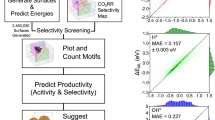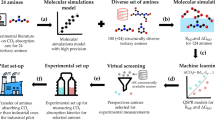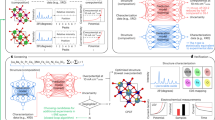Abstract
The rapid increase in global energy demand and the need to replace carbon dioxide (CO2)-emitting fossil fuels with renewable sources have driven interest in chemical storage of intermittent solar and wind energy1,2. Particularly attractive is the electrochemical reduction of CO2 to chemical feedstocks, which uses both CO2 and renewable energy3,4,5,6,7,8. Copper has been the predominant electrocatalyst for this reaction when aiming for more valuable multi-carbon products9,10,11,12,13,14,15,16, and process improvements have been particularly notable when targeting ethylene. However, the energy efficiency and productivity (current density) achieved so far still fall below the values required to produce ethylene at cost-competitive prices. Here we describe Cu-Al electrocatalysts, identified using density functional theory calculations in combination with active machine learning, that efficiently reduce CO2 to ethylene with the highest Faradaic efficiency reported so far. This Faradaic efficiency of over 80 per cent (compared to about 66 per cent for pure Cu) is achieved at a current density of 400 milliamperes per square centimetre (at 1.5 volts versus a reversible hydrogen electrode) and a cathodic-side (half-cell) ethylene power conversion efficiency of 55 ± 2 per cent at 150 milliamperes per square centimetre. We perform computational studies that suggest that the Cu-Al alloys provide multiple sites and surface orientations with near-optimal CO binding for both efficient and selective CO2 reduction17. Furthermore, in situ X-ray absorption measurements reveal that Cu and Al enable a favourable Cu coordination environment that enhances C–C dimerization. These findings illustrate the value of computation and machine learning in guiding the experimental exploration of multi-metallic systems that go beyond the limitations of conventional single-metal electrocatalysts.
This is a preview of subscription content, access via your institution
Access options
Access Nature and 54 other Nature Portfolio journals
Get Nature+, our best-value online-access subscription
$29.99 / 30 days
cancel any time
Subscribe to this journal
Receive 51 print issues and online access
$199.00 per year
only $3.90 per issue
Buy this article
- Purchase on Springer Link
- Instant access to full article PDF
Prices may be subject to local taxes which are calculated during checkout




Similar content being viewed by others
Data availability
Source data to generate figures and tables are available from the corresponding authors on reasonable request.
Code availability
Code to generate figures and tables is available from the corresponding authors on reasonable request.
References
Lin, S. et al. Covalent organic frameworks comprising cobalt porphyrins for catalytic CO2 reduction in water. Science 349, 1208–1213 (2015).
Schreier, M. et al. Solar conversion of CO2 to CO using Earth-abundant electrocatalysts prepared by atomic layer modification of CuO. Nat. Energy 2, 17087 (2017).
Dinh, C. et al. Sustained high-selectivity CO2 electroreduction to ethylene via hydroxide-mediated catalysis at an abrupt reaction interface. Science 360, 783–787 (2018).
Li, C. et al. Electroreduction of carbon monoxide to liquid fuel on oxide-derived nanocrystalline copper. Nature 508, 504–507 (2014).
Lu, Q. et al. A selective and efficient electrocatalyst for carbon dioxide reduction. Nat. Commun. 5, 3242 (2014).
Gao, S. et al. Partially oxidized atomic cobalt layers for carbon dioxide electroreduction to liquid fuel. Nature 529, 68–71 (2016).
Li, Y. C. et al. Electrolysis of CO2 to syngas in bipolar membrane-based electrochemical cells. ACS Energy Lett. 1, 1149–1153 (2016).
Jeanty, P. et al. Upscaling and continuous operation of electrochemical CO2 to CO conversion in aqueous solutions on silver gas diffusion electrodes. J. CO 2 Util. 24, 454–462 (2018).
Hori, Y. et al. Selective formation of C2 compounds from electrochemical reduction of CO2 at a series of copper single crystal electrodes. J. Phys. Chem. B 106, 15–17 (2002).
Yano, H. et al. Selective electrochemical reduction of CO2 to ethylene at a three-phase interface on copper(I) halide-confined Cu-mesh electrodes in acidic solutions of potassium halides. J. Electroanal. Chem. 565, 287–293 (2004).
Peterson, A. A. et al. How copper catalyzes the electroreduction of carbon dioxide into hydrocarbon fuels. Energy Environ. Sci. 3, 1311–1315 (2010).
Kortlever, R. et al. Catalysts and reaction pathways for the electrochemical reduction of carbon dioxide. J. Phys. Chem. Lett. 6, 4073–4082 (2015).
Mistry, H. et al. Highly selective plasma-activated copper catalysts for carbon dioxide reduction to ethylene. Nat. Commun. 7, 12123 (2016).
Li, Y. et al. Structure-sensitive CO2 electroreduction to hydrocarbons on ultrathin 5-fold twinned copper nanowires. Nano Lett. 17, 1312–1317 (2017).
Lum, Y. et al. Optimizing C–C coupling on oxide-derived copper catalysts for electrochemical CO2 reduction. J. Phys. Chem. C 121, 14191–14203 (2017).
De Luna, P. et al. Catalyst electro-redeposition controls morphology and oxidation state for selective carbon dioxide reduction. Nat. Catal. 1, 103–110 (2018).
Liu, X. et al. Understanding trends in electrochemical carbon dioxide reduction rates. Nat. Commun. 8, 15438 (2017).
Tran, K. et al. Active learning across intermetallics to guide discovery of electrocatalysts for CO2 reduction and H2 evolution. Nat. Catal. 1, 696–703 (2018).
van der Maaten, L. Accelerating t-SNE using tree-based algorithms. J. Mach. Learn. Res. 15, 3221–3245 (2014).
Davis, L. E. et al. Handbook of Auger Electron Spectroscopy 2nd edn (Physical Electronics Industries, 1976).
Persson, K. A. et al. Prediction of solid-aqueous equilibria: scheme to combine first-principles calculations of solids with experimental aqueous states. Phys. Rev. B 85, 235438 (2012).
Montoya, J. H. et al. A high-throughput framework for determining adsorption energies on solid surfaces. npj Comput. Mater. 3, 14 (2017).
Xiao, H. et al. Atomistic mechanisms underlying selectivities in C1 and C2 products from electrochemical reduction of CO on Cu (111). J. Am. Chem. Soc. 139, 130–136 (2017).
Xiao, H. et al. Cu metal embedded in oxidized matrix catalyst to promote CO2 activation and CO dimerization for electrochemical reduction of CO2. Proc. Natl Acad. Sci. USA 114, 6685–6688 (2017).
Jain, A. et al. The Materials Project: a materials genome approach to accelerated materials innovation. APL Mater. 1, 011002 (2013).
Nørskov, J. K. et al. Trends in the exchange current for hydrogen evolution. J. Electrochem. Soc. 152, J23–J26 (2005).
Wang, L. et al. Electrochemical carbon monoixde reduction on polycrystalline copper: effects of potential, pressure, and pH on selectivity toward multicarbon and oxygenated products. ACS Catal. 8, 7445–7454 (2018).
Liu, M. et al. Enhanced electrocatalytic CO2 reduction via field-induced reagent concentration. Nature 537, 382–386 (2016).
Zeng, Z. et al. Stabilization of ultrathin (hydroxy)oxide films on transition metal substrates for electrochemical energy conversion. Nat. Energy 2, 17070 (2017).
She, Z. W. et al. Combining theory and experiment in electrocatalysis: Insights into materials design. Science 355, 146 (2017).
Larrazábal, G. O. et al. Building blocks for high performance in electrocatalytic CO2 reduction: materials, optimization strategies, and device engineering. J. Phys. Chem. Lett. 8, 3933–3944 (2017).
Whipple, D. T. et al. Prospects of CO2 utilization via direct heterogeneous electrochemical reduction. J. Phys. Chem. Lett. 1, 3451–3458 (2010).
De Luna, P. et al. What would it take for renewably powered electrosynthesis to displace petrochemical processes? Science 364, eaav3506 (2019).
Acknowledgements
This work was supported financially by the Ontario Research Fund Research-Excellence Program, the Natural Sciences and Engineering Research Council (NSERC) of Canada, the Canadian Institute for Advanced Research (CIFAR) Bio-Inspired Solar Energy programme, the University of Toronto Connaught programme, and TOTAL American Services. M.Z. thanks the National Natural Science Foundation of China (grant number 91963121), and S. Tolbert from the University of California, Los Angeles for discussions of de-alloying. S.S. thanks the National Key Research and Development Program of China (grant number 2016YFB0700205) and the National Natural Science Foundation of China (grant number U1632273). We thank R. Morris and D. Sinton from the University of Toronto for discussions. We thank C. McCallum, R. Wolowiec, D. Kopilovic, S. Boccia, A. Ip, M. Liu, Y. Pang, M. Askerka, A. Seifitokaldani, T. T. Zhuang and Z. Liang from the University of Toronto, Canada and C.-W. Huang, L.-J. Chen from National Tsing Hua University, Taiwan, for their help during the course of study. We thank the beamline scientists from the Source optimisée de lumière d’énergie intermédiaire du LURE (SOLEIL) Synchrotron in France for performing in situ X-ray absorption analyses. This research used resources of the National Energy Research Scientific Computing Center, a Department of Energy (DOE) Office of Science User Facility supported by the Office of Science of the US Department of Energy under contract number DE-AC02-05CH11231. Computations were performed on the Southern Ontario Smart Computing Innovation Platform (SOSCIP) Consortium’s Blue Gene/Q computing platform. SOSCIP is funded by the Federal Economic Development Agency of Southern Ontario, the Province of Ontario, IBM Canada Ltd, Ontario Centres of Excellence, MITACS and 15 Ontario academic member institutions.
Author information
Authors and Affiliations
Contributions
E.H.S. supervised the project. M.Z. and E.H.S. conceived the idea. M.Z. and C.W. designed and carried out the experiments. K.T., Z.Y. and Z.U. performed the machine learning studies. K.T., Z.Y., Z.U., Y.M., Z.W. O.V., P.D.L., M.A., M.Z. and E.H.S. discussed the machine learning results. Y.M., Z.W. O.V., P.D.L., M.A., A.S., F.C., K.T., Z.Y. and Z.U. carried out the DFT simulations. P.B. carried out the Auger electron spectroscopy analyses. S.S. and P.D.L. performed X-ray absorption spectroscopy measurements. C.-S.T. and S.-C.L. carried out the TEM analyses. C.-T.D., A.S.R., C.-S.T., M.A., M.L., A.S., Y.P. and A.I. contributed to the discussion of the results. All authors discussed the results and assisted during manuscript preparation.
Corresponding authors
Ethics declarations
Competing interests
The authors declare no competing interests.
Additional information
Peer review information Nature thanks Hailiang Wang and the other, anonymous, reviewer(s) for their contribution to the peer review of this work.
Publisher’s note Springer Nature remains neutral with regard to jurisdictional claims in published maps and institutional affiliations.
Supplementary information
Supplementary Information
This file contains Supplementary Methods, which includes Supplementary Figures 1-68 and Supplementary Tables 1-11.
Rights and permissions
About this article
Cite this article
Zhong, M., Tran, K., Min, Y. et al. Accelerated discovery of CO2 electrocatalysts using active machine learning. Nature 581, 178–183 (2020). https://doi.org/10.1038/s41586-020-2242-8
Received:
Accepted:
Published:
Issue Date:
DOI: https://doi.org/10.1038/s41586-020-2242-8
This article is cited by
-
Pure-water-fed, electrocatalytic CO2 reduction to ethylene beyond 1,000 h stability at 10 A
Nature Energy (2024)
-
Integrating hydrogen utilization in CO2 electrolysis with reduced energy loss
Nature Communications (2024)
-
Active learning guides discovery of a champion four-metal perovskite oxide for oxygen evolution electrocatalysis
Nature Materials (2024)
-
Large language model enhanced corpus of CO2 reduction electrocatalysts and synthesis procedures
Scientific Data (2024)
-
Selective and energy-efficient electrosynthesis of ethylene from CO2 by tuning the valence of Cu catalysts through aryl diazonium functionalization
Nature Energy (2024)
Comments
By submitting a comment you agree to abide by our Terms and Community Guidelines. If you find something abusive or that does not comply with our terms or guidelines please flag it as inappropriate.



